The Social Cost of Urban Sprinkling
Abstract
1. Introduction
2. Sprinkling vs. Sprawl
3. Materials and Methods
- the distribution of the buildings in 1950, deduced from the 1:25000 topographic map of the Military Geographical Institute;
- the distribution of the buildings in 2013;
- the settlement of the population in the various census sections; and
- the network of roads, classified by category, for each of the selected municipalities.
3.1. Study Area
3.2. Sprinkling Index and Cost Estimation
- the variation in sprinkling, defined by the difference,ΔSPX,I = SPXi(2013) − SPXi(1950);
- the mean square deviation, S, of the elevation values (X) measured every 5 square meters within the reference mesh,
4. Results
5. Discussion
6. Conclusions
Author Contributions
Funding
Conflicts of Interest
References
- Burchell, R.W.; Downs, A.; McCann, B.; Mukherji, S. Sprawl Costs: Economic Impacts of Unchecked Development; Island Press: Washington, DC, USA, 2005; 197p. [Google Scholar]
- Bruegmann, R. Sprawl: A Compact History, 1st ed.; University of Chicago Press: Chicago, IL, USA, 2005. [Google Scholar]
- Tu, J.; Xia, Z.G.; Clarke, K.C.; Frei, A. Impact of urban sprawl on water quality in eastern Massachusetts, USA. Environ. Manag. 2007, 40, 183–200. [Google Scholar] [CrossRef]
- Borrego, C.; Martins, H.; Tchepel, O.; Salmim, L.; Monteiro, A.; Miranda, A.I. How urban structure can affect city sustainability from an air quality perspective. Environ. Model. & Softw. 2006, 21, 461–467. [Google Scholar]
- Bhatta, B. Analysis of Urban Growth and Sprawl from Remote Sensing Data; Springer: Berlin/Heidelberg, Germany, 2010; pp. 17–36. [Google Scholar]
- Stone, B. Urban sprawl and air quality in large US cities. J. Environ. Manag. 2008, 86, 688–698. [Google Scholar] [CrossRef] [PubMed]
- Wilson, B.; Chakraborty, A. The environmental impacts of sprawl: Emergent themes from the past decade of planning research. Sustainability 2013, 5, 3302–3327. [Google Scholar] [CrossRef]
- Ewing, R.H. Characteristics, causes, and effects of sprawl: A literature review. In Urban Ecology; Marzluff, J., Shulenberger, E., Endlicher, W., Alberti, M., Bradley, G., Ryan, C., ZumBrunnen, C., Simon, U., Eds.; Springer: New York, NY, USA, 2008; pp. 519–535. [Google Scholar]
- Travisi, C.M.; Camagni, R.; Nijkamp, P. Impacts of urban sprawl and commuting: A modelling study for Italy. J. Transp. Geogr. 2010, 18, 382–392. [Google Scholar] [CrossRef]
- Johnson, M.P. Environmental impacts of urban sprawl: A survey of the literature and proposed research agenda. Environ. Plan. A 2001, 33, 717–735. [Google Scholar] [CrossRef]
- Gonzalez, G.A. Urban sprawl, global warming and the limits of ecological modernization. Environ. Politics 2005, 14, 344–362. [Google Scholar] [CrossRef]
- Camagni, R.; Cristina, M.G.; Rigamonti, P. Urban mobility and urban form: The social and environmental costs of different patterns of urban expansion. Ecol. Econ. 2002, 40, 199–216. [Google Scholar] [CrossRef]
- Newman, P.W.G.; Kenworthy, J.R.; Vintila, P. Can we overcome automobile dependence? Physical planning in an age of urban cynicism. Cities 1995, 12, 53–65. [Google Scholar] [CrossRef]
- Cervero, R. Jobs—Housing balance revisited: Trends and impacts in the San Francisco Bay Area. J. Am. Plan. Assoc. 1996, 62, 492–511. [Google Scholar] [CrossRef]
- Power, A. Social exclusion and urban sprawl: Is the rescue of cities possible? Reg. Stud. 2001, 35, 731–742. [Google Scholar] [CrossRef]
- Le Goix, R. Gated communities: Sprawl and social segregation in Southern California. Hous. Stud. 2005, 20, 323–343. [Google Scholar] [CrossRef]
- Brueckner, J.K. Urban Sprawl: Diagnosis and Remedies. Int. Reg. Sci. Rev. 2000, 23, 160–171. [Google Scholar] [CrossRef]
- Litynski, P.; Holuj, A. Urban Sprawl Costs: The Valuation of Households’ Losses in Poland. J. Settl. Spat. Plan. 2017, 8, 11–35. [Google Scholar] [CrossRef]
- Ladd, H.F. Population Growth, Density and the Costs of Providing Public Services. Urban Stud. 1992, 29, 273–295. [Google Scholar] [CrossRef]
- Carruthers, J.I.; Ulfarsson, G.F. Urban sprawl and the cost of public services. Environ. Plan. B Plan. Des. 2003, 30, 503–522. [Google Scholar] [CrossRef]
- Hortas-Rico, M.; Sole′-Olle′, A. Does urban sprawl increase the costs of providing local public services? Evidence from Spanish municipalities. Urban Stud. 2010, 47, 1513–1540. [Google Scholar] [CrossRef]
- Romano, B.; Zullo, F.; Fiorini, L.; Ciabò, S.; Marucci, A. Sprinkling: An Approach to Describe Urbanization Dynamics in Italy. Sustainability 2017, 9, 97. [Google Scholar] [CrossRef]
- Saganeiti, L.; Pilogallo, A.; Scorza, F.; Mussuto, G.; Murgante, B. Spatial indicators to evaluate urban fragmentation in Basilicata region. In International Conference on Computational Science and Its Applications; Springer: Cham, Switzerland, 2018; Volume 10964, ISBN 9783319951737. [Google Scholar]
- Saganeiti, L.; Favale, A.; Pilogallo, A.; Scorza, F.; Murgante, B. Assessing Urban Fragmentation at Regional Scale using Sprinkling Indexes. Sustainability 2018, 10, 3274. [Google Scholar] [CrossRef]
- Nechyba, T.J.; Walsh, R.P. Urban sprawl. J. Econ. Perspect. 2004, 18, 177–200. [Google Scholar] [CrossRef]
- Jaeger, J.A.G.; Bertiller, R.; Schwick, C.; Kienast, F. Suitability criteria for measures of urban sprawl. Ecol. Indic. 2010, 10, 397–406. [Google Scholar] [CrossRef]
- Kew, B.; Lee, B.D. Measuring sprawl across the urban rural continuum using an amalgamated sprawl index. Sustainability 2013, 5, 1806–1828. [Google Scholar] [CrossRef]
- Galster, G.; Hanson, R.; Ratcliffe, M.R.; Wolman, H.; Coleman, S.; Freihage, J. Wrestling sprawl to the ground: Defining and measuring an elusive concept. Hous. Policy Debate 2001, 12, 681–717. [Google Scholar] [CrossRef]
- Brueckner, J.K. Urban Sprawl: Lessons from Urban Economics. Brook.-Whart. Pap. Urban Aff. 2001, 2001, 65–97. [Google Scholar] [CrossRef]
- Urban Sprawl | Definition of Urban Sprawl at Dictionary.com. Available online: https://www.merriam-webster.com/dictionary/urbansprawl (accessed on 14 December 2019).
- Romano, B.; Zullo, F.; Ciabò, S.; Fiorini, L.; Marucci, A. Geografie e modelli di 50 anni di consumo di suolo in Italia. Sci. E Ric. 2015, 5, 17–28. [Google Scholar]
- Xu, G.; Dong, T.; Cobbinah, P.B.; Jiao, L.; Sumari, N.S.; Chai, B.; Liu, Y. Urban expansion and form changes across African cities with a global outlook: Spatiotemporal analysis of urban land densities. J. Clean. Prod. 2019, 224, 802–810. [Google Scholar] [CrossRef]
- Urbieta, P.; Fernandez, E.; Ramos, L.; Méndez Martínez, G.; Bento, R. A land-cover based urban dispersion indicator suitable for highly dispersed, discontinuously artificialized territories: The case of continental Portugal. Land Use Policy 2019, 85, 92–103. [Google Scholar] [CrossRef]
- Saganeiti, L.; Pilogallo, A.; Faruolo, G.; Scorza, F.; Murgante, B. Territorial Fragmentation and Renewable Energy Source Plants: Which Relationship? Sustainability 2020, 12, 1828. [Google Scholar] [CrossRef]
- Sudhira, H.S.; Ramachandra, T.V.; Jagadish, K.S. Urban sprawl: Metrics, dynamics and modelling using GIS. Int. J. Appl. Earth Obs. Geoinf. 2004, 5, 29–39. [Google Scholar] [CrossRef]
- Malpezzi, S.; Guo, W.K. Measuring Sprawl: Alternative Measures of Urban Form in U.S. Metropolitan Areas; The Center for Urban Land Economics Research; University of Wisconsin: Madison, WI, USA, 2001. [Google Scholar]
- Bhatta, B.; Saraswati, S.; Bandyopadhyay, D. Urban sprawl measurement from remote sensing data. Appl. Geogr. 2010, 30, 731–740. [Google Scholar] [CrossRef]
- Hasse, J. A geospatial approach to measuring new development tracts for characteristics of sprawl. Landsc. J. 2004, 23, 52–67. [Google Scholar] [CrossRef]
- Hennig, E.I.; Schwick, C.; Soukup, T.; Orlitová, E.; Kienast, F.; Jaeger, J.A.G. Multi-scale analysis of urban sprawl in Europe: Towards a European de-sprawling strategy. Land Use Policy 2015, 49, 483–498. [Google Scholar] [CrossRef]
- Torrens, P.M. A toolkit for measuring sprawl. Appl. Spat. Anal. 2008, 1, 5–36. [Google Scholar] [CrossRef]
- Istat.it. Available online: https://www.istat.it/ (accessed on 5 April 2018).
- Scorza, F.; Pilogallo, A.; Saganeiti, L.; Murgante, B.; Pontrandolfi, P. Comparing the territorial performances of Renewable Energy Sources’ plants with an integrated Ecosystem Services loss assessment: A case study from the Basilicata region (Italy). Sustain. Cities Soc. 2020, 56, 102082. [Google Scholar] [CrossRef]


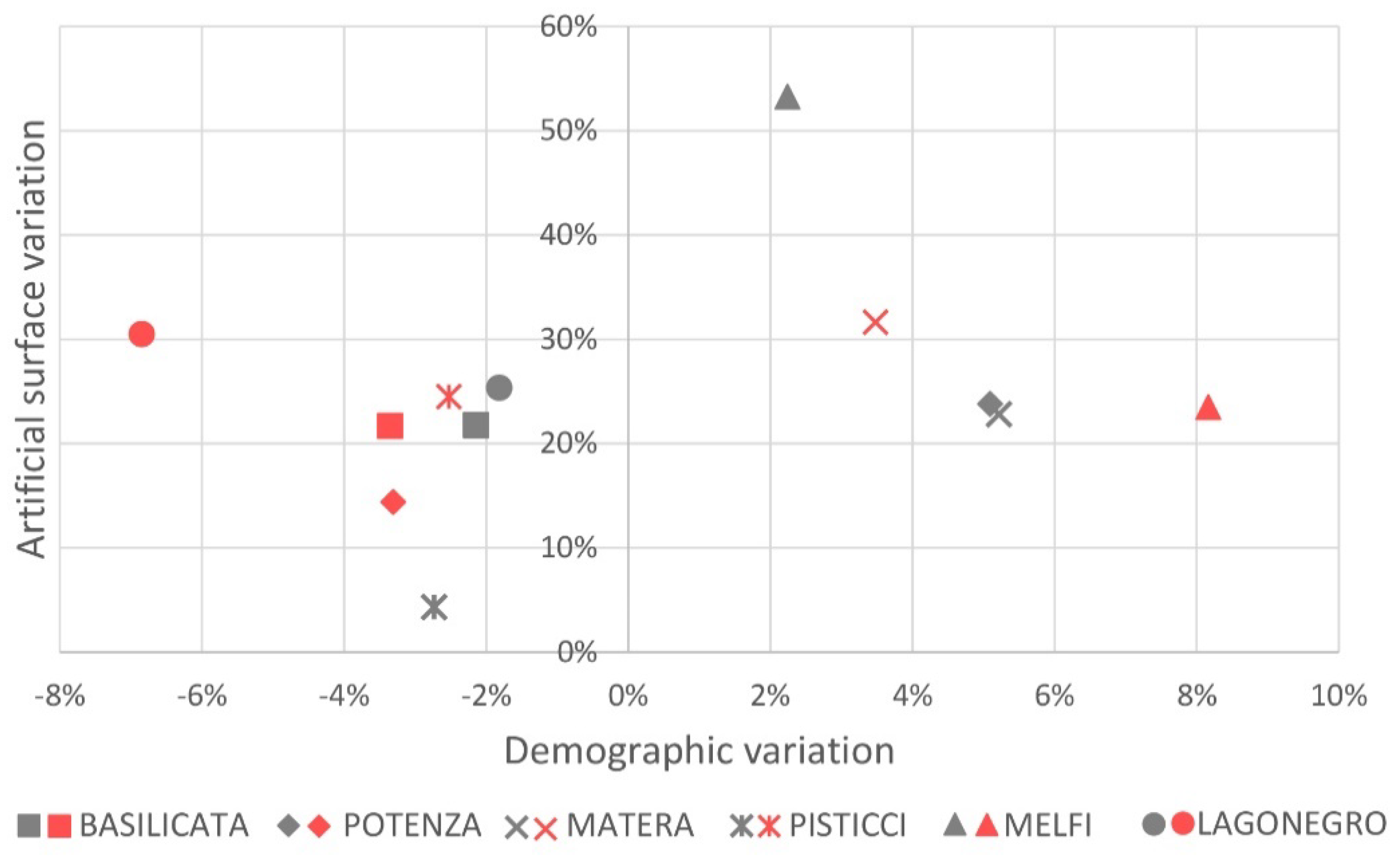
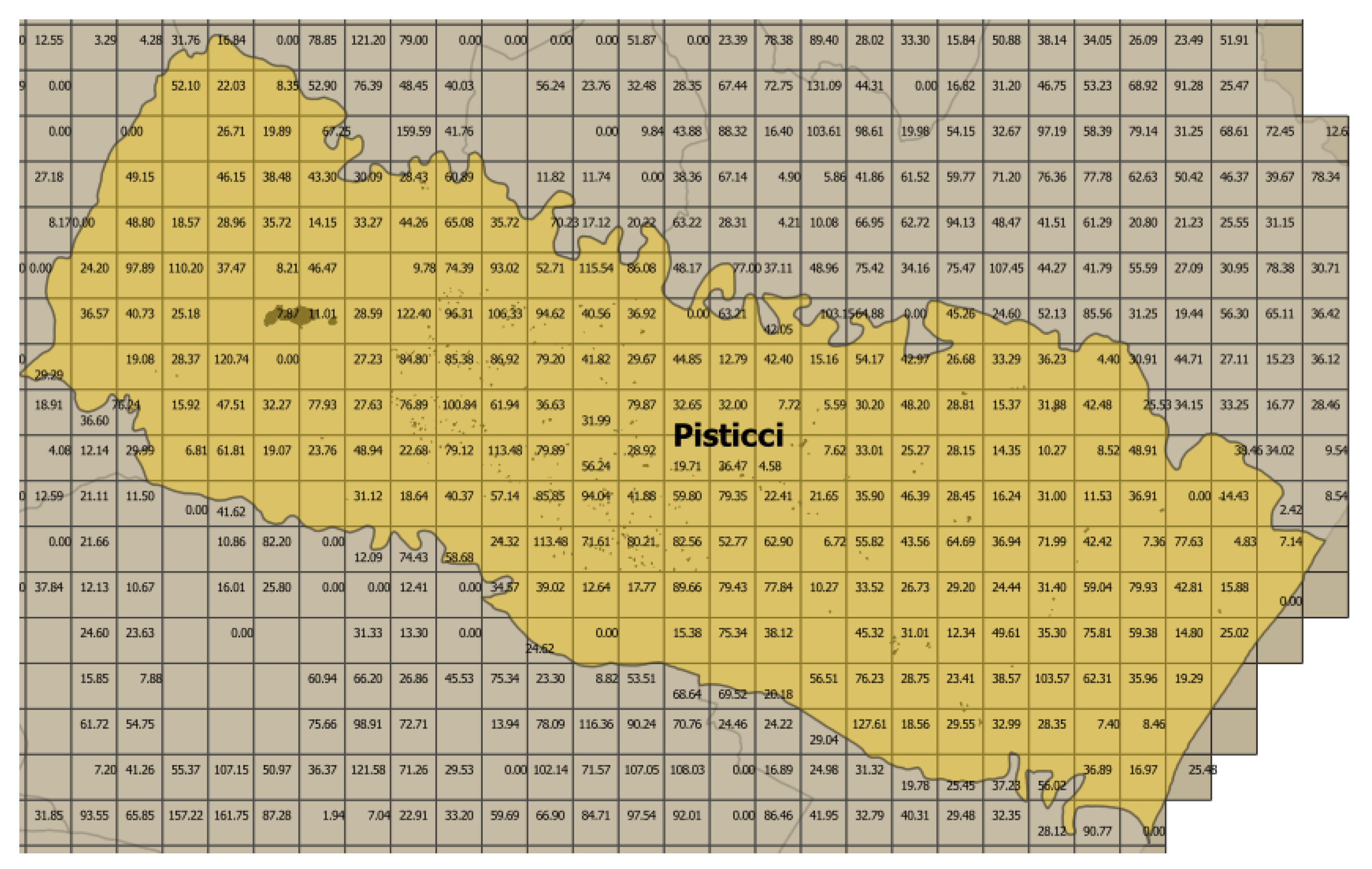
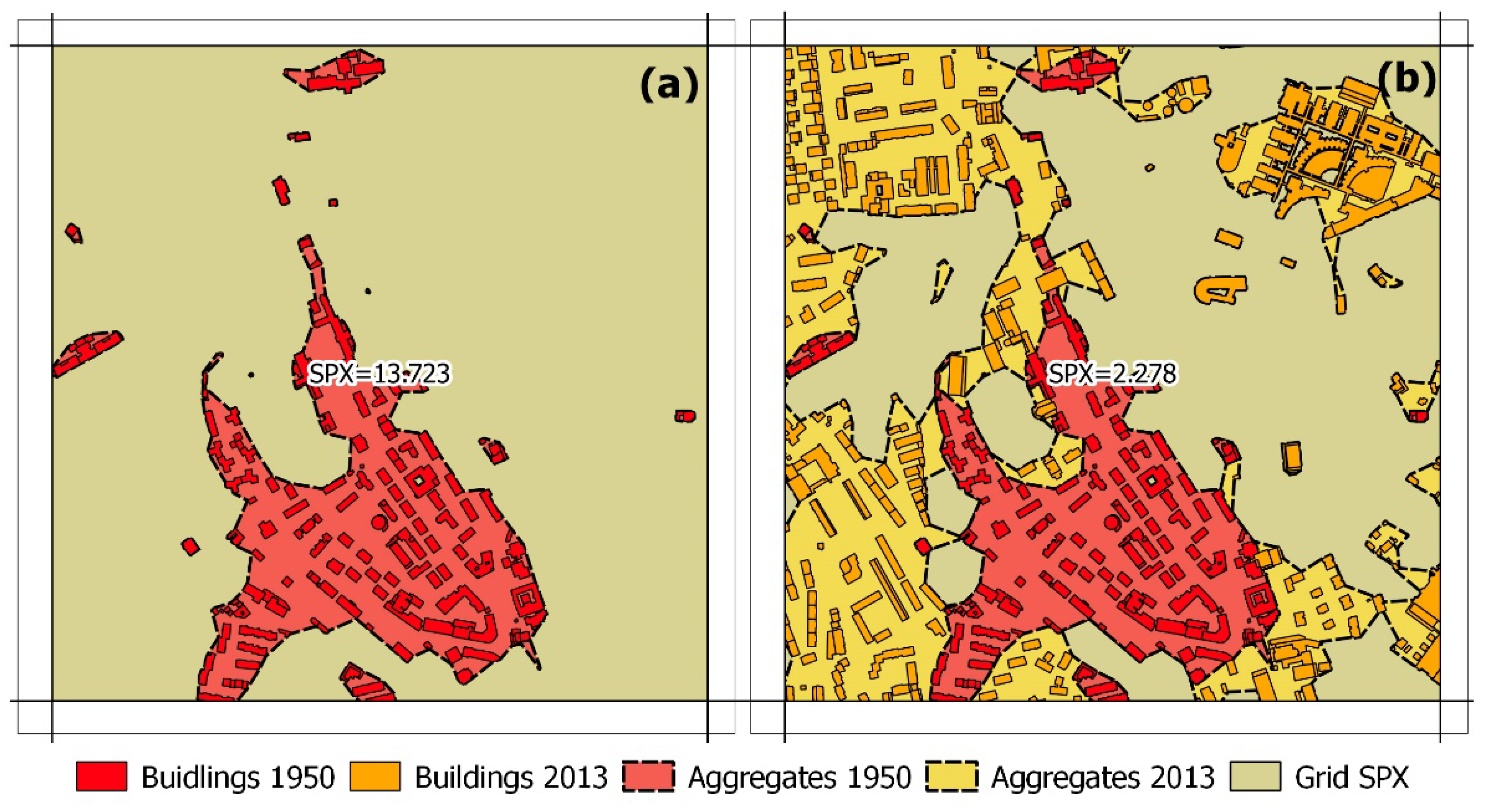


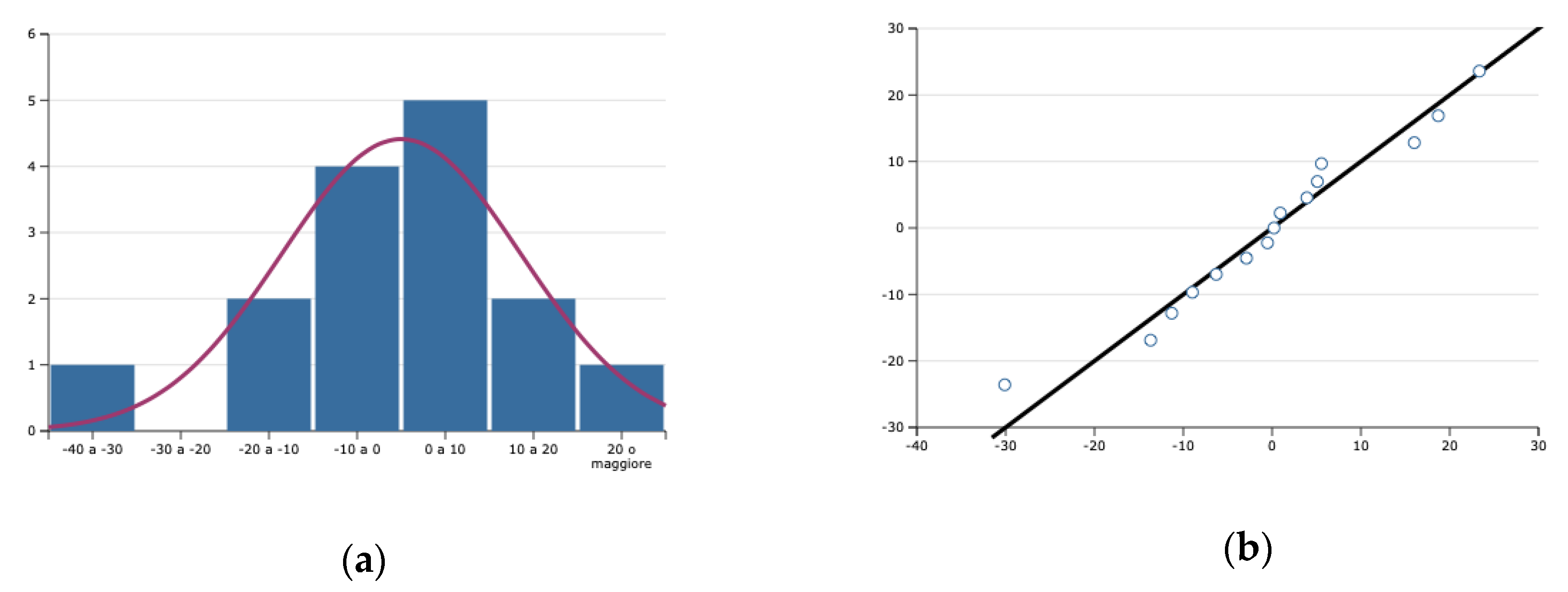
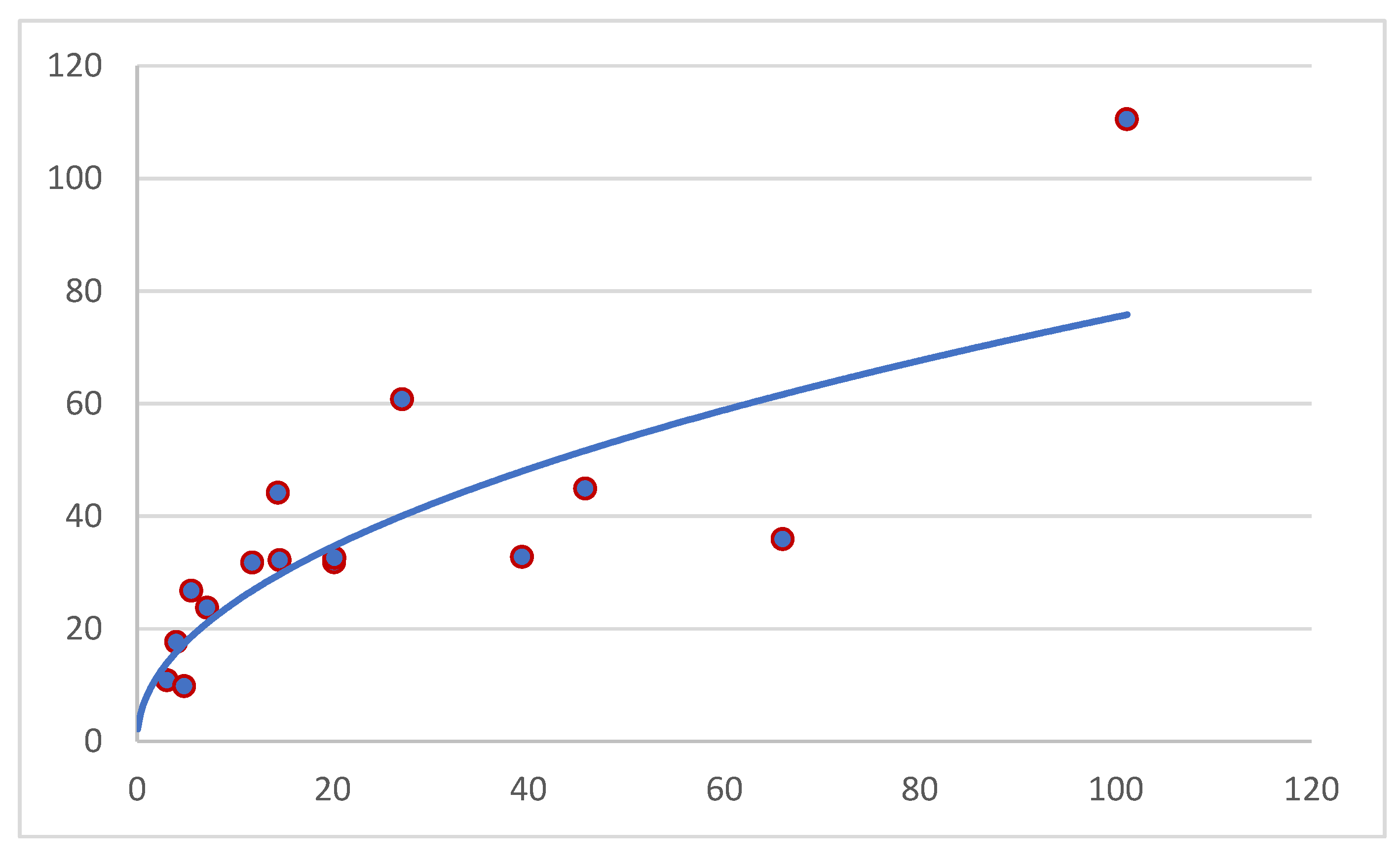
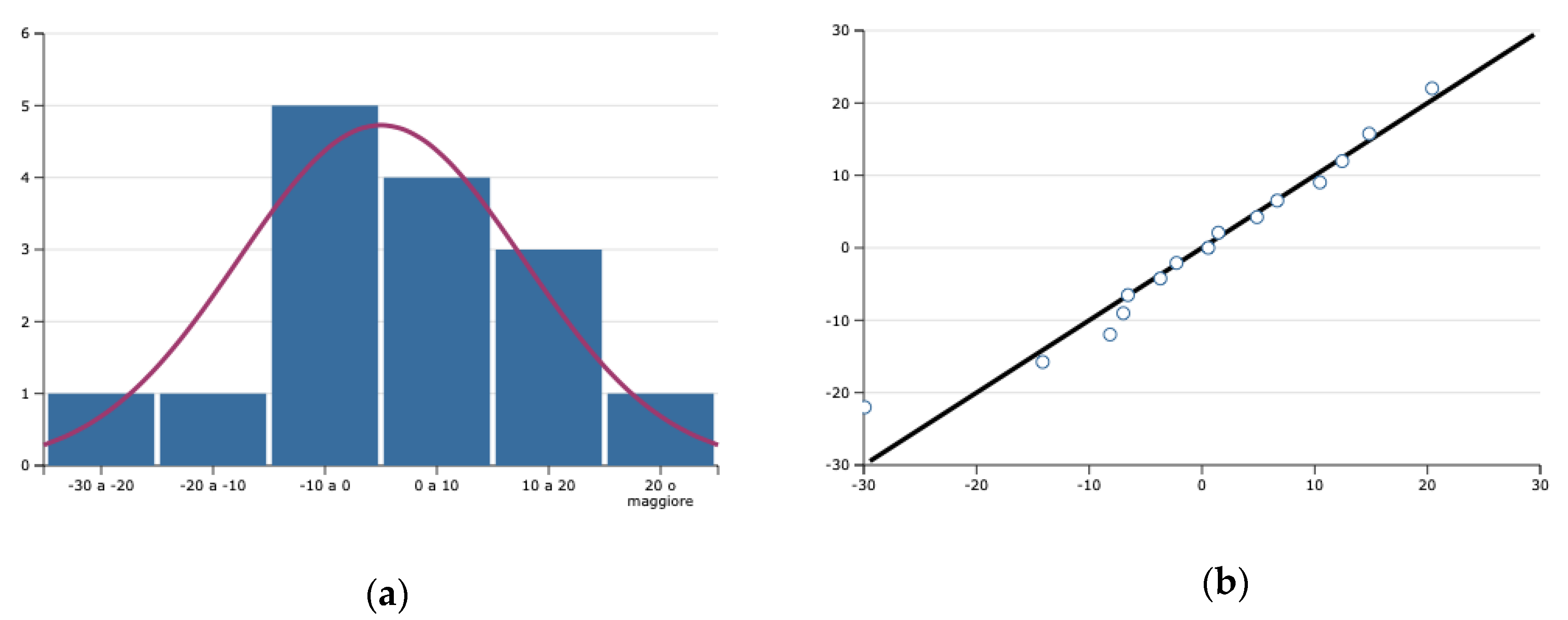
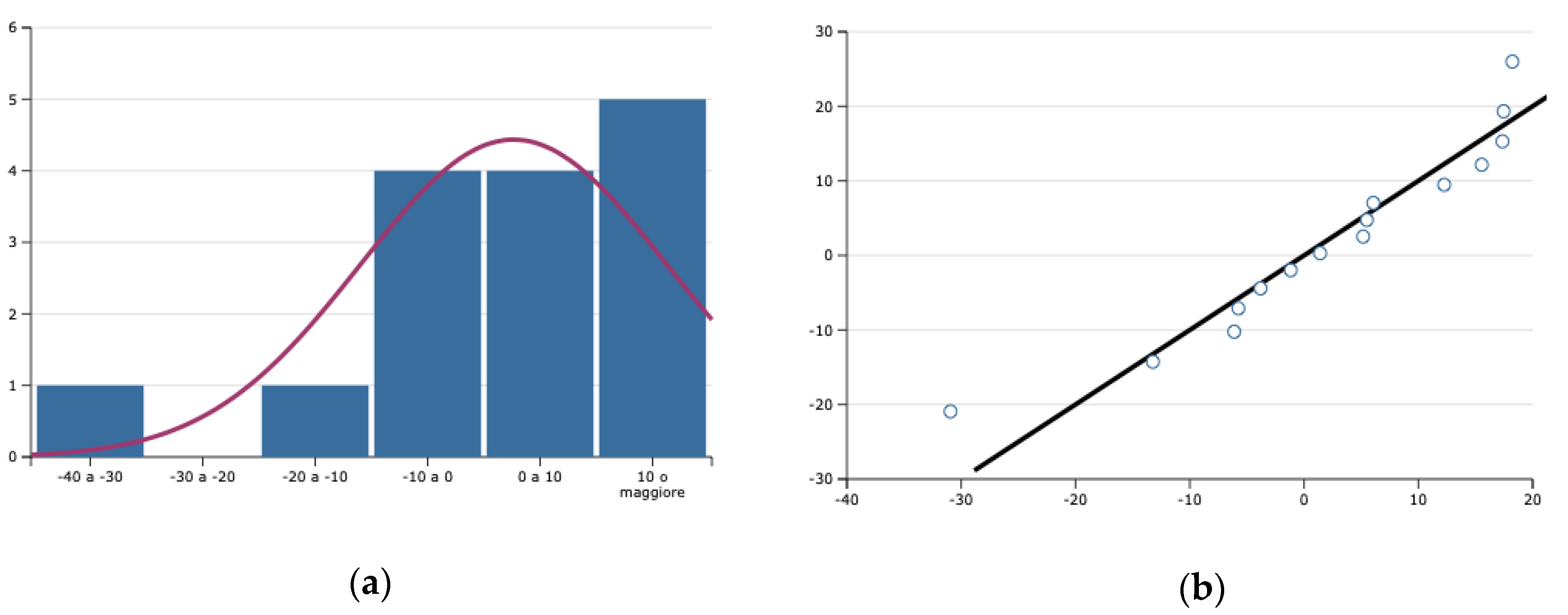
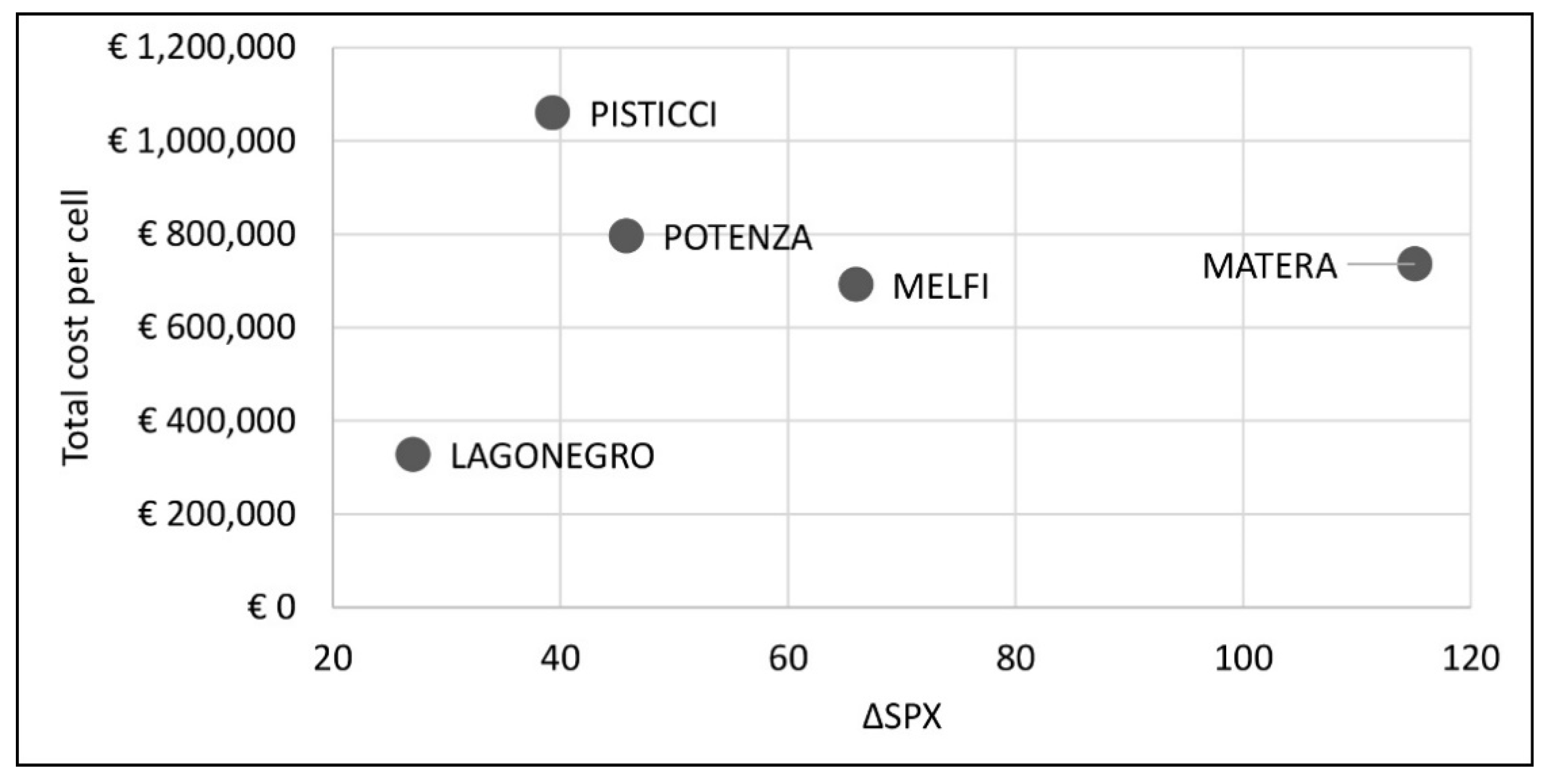
| Fragmentation Degree | SPX 1 |
|---|---|
| Not fragmented | SPX = 0 |
| Low fragmentation | 0 < SPX < 50 |
| Medium–low fragmentation | 50 ≤ SPX < 100 |
| Medium fragmentation | 100 ≤ SPX < 150 |
| Medium–high fragmentation | 150 ≤ SPX < 200 |
| High fragmentation | SPX ≥ 200 |
| Town | Response | Predictors | |
|---|---|---|---|
| Cost (€/m3) | ΔSPX | S | |
| Potenza | 32.196 | 14.573 | 47.68 |
| 44.907 | 45.795 | 27.49 | |
| Lagonegro | 44.163 | 14.403 | 37.165 |
| 60.807 | 27.085 | 81.987 | |
| 26.754 | 5548 | 68.53 | |
| Matera | 10.851 | 3055 | 7917 |
| 110.563 | 101.17 | 855 | |
| Melfi | 31.865 | 20.161 | 4.46 |
| 35.918 | 65.991 | 21.789 | |
| 17.642 | 4023 | 52.988 | |
| Pisticci | 32.608 | 20.177 | 24.51 |
| 23.771 | 7177 | 4935 | |
| 31.779 | 11.77 | 8242 | |
| 9821 | 4817 | 17.932 | |
| 32.786 | 39.344 | 29.444 | |
| R | 0.8301 | R-squared | 0.68906 | Adjusted R-squared | 0.66515 | ||
| MSE | 198.02889 | S | 14.07227 | MAPE | 33.34135 | ||
| Durbin–Watson (DW) | 1.65484 | Log likelihood | −59.87392 | ||||
| Akaike inf. criterion (AIC) | 8.24986 | AICc | 8.27037 | ||||
| Schwarz criterion (BIC) | 8.34426 | Hannan–Quinn criterion (HQC) | 8.24885 | ||||
| PRESS | 5298.72 | PRESS RMSE | 18.79489 | Adjusted R-squared | 0.36001 | ||
| Coefficients | Std Err | LCL 1 | UCL 1 | t Stat | Value p | H0 (5%) | |
| Constant | 17.58168 | 5.05288 | 6.66559 | 28.49776 | 3.47953 | 0.00407 | rejected |
| ΔSPX | 0.73413 | 0.13677 | 0.43864 | 1.02961 | 5.36742 | 0.00013 | rejected |
| R | R-squared | Adjusted R-squared | Standard Error of the Estimate | ||
|---|---|---|---|---|---|
| 0.840 | 0.706 | 0.683 | 0.343 | ||
| Coefficients | Std Err | Std Coefficients | T Stat | Value p | |
| ln(ΔSPX) | 0.484 | 0.087 | 0.840 | 5.585 | 0.000 |
| Constant | 8.123 | 2.062 | 3.940 | 0.002 | |
| R | 0.85385 | R-Squared | 0.72906 | Adjusted R-Squared | 0.6839 | ||
| MSE | 186.9357 | S | 13.67244 | MAPE | 30.73977 | ||
| Durbin–Watson (DW) | 1.68796 | Log likelihood | −58.84124 | ||||
| Akaike inf. criterion (AIC) | 8.2455 | AICc | 8.31216 | ||||
| Schwarz criterion (BIC) | 8.38711 | Hannan–Quinn criterion (HQC) | 8.24399 | ||||
| PRESS | 5738.40 | PRESS RMSE | 19.55914 | Adjusted R-squared | 0.30691 | ||
| Coefficients | Std Err | LCL | UCL | t Stat | Value p | H0 (5%) | |
| Constant | 10.55533 | 7.20909 | −5.15192 | 26.26258 | 1.46417 | 0.16885 | accepted |
| ΔSPX | 0.76928 | 0.13549 | 0.47408 | 1.06448 | 5.67785 | 0.0001 | rejected |
| S | 0.20707 | 0.15558 | −0.13191 | 0.54604 | 1.33096 | 0.20794 | accepted |
| R | 0.95194 | R-Squared | 0.90619 | Adjusted R-Squared | 0.89898 | ||
| MSE | 203.38309 | S | 14.26124 | MAPE | 32.93767 | ||
| Durbin–Watson (DW) | 1.64565 | Log likelihood | −60.07401 | ||||
| Akaike inf. criterion (AIC) | 8.27653 | AICc | 8.33807 | ||||
| Schwarz criterion (BIC) | 8.37094 | Hannan–Quinn criterion (HQC) | 8.27553 | ||||
| PRESS | 4918.98 | PRESS RMSE | 18.1089 | Adjusted R-squared | 0.82548 | ||
| Coefficients | Std Err | LCL | UCL | t Stat | Value p | H0 (5%) | |
| Constant | 0 | ||||||
| ΔSPX | 0.88968 | 0.11232 | 0.64703 | 1.13233 | 7.92095 | 2.49E-06 | rejected |
| S | 0.37388 | 0.11051 | 0.13514 | 0.61261 | 3.38322 | 0.0049 | rejected |
© 2020 by the authors. Licensee MDPI, Basel, Switzerland. This article is an open access article distributed under the terms and conditions of the Creative Commons Attribution (CC BY) license (http://creativecommons.org/licenses/by/4.0/).
Share and Cite
Manganelli, B.; Murgante, B.; Saganeiti, L. The Social Cost of Urban Sprinkling. Sustainability 2020, 12, 2236. https://doi.org/10.3390/su12062236
Manganelli B, Murgante B, Saganeiti L. The Social Cost of Urban Sprinkling. Sustainability. 2020; 12(6):2236. https://doi.org/10.3390/su12062236
Chicago/Turabian StyleManganelli, Benedetto, Beniamino Murgante, and Lucia Saganeiti. 2020. "The Social Cost of Urban Sprinkling" Sustainability 12, no. 6: 2236. https://doi.org/10.3390/su12062236
APA StyleManganelli, B., Murgante, B., & Saganeiti, L. (2020). The Social Cost of Urban Sprinkling. Sustainability, 12(6), 2236. https://doi.org/10.3390/su12062236







